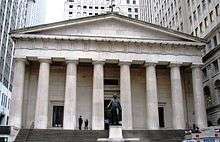Tuckahoe marble

Tuckahoe marble (also known as Inwood marble) is a type of marble named after the village of Tuckahoe, New York or alternatively the neighborhood of Inwood in Manhattan, New York City. It is found in Eastchester and extending southward to parts of the Bronx, such as Kingsbridge, Mott Haven, Melrose and Tremont and Marble Hill. It has long been quarried at Tuckahoe as well as at Ossining, Hastings, and Thornwood, hence the alternate name, Westchester marble. It is part of the Inwood Formation, which also intrudes into western Connecticut. It dates from the Late Cambrian to the Early Ordovician ages (~484 ma ago).
Description and geology
Inwood marble is a high quality marble first discovered in 1822 in the town of Eastchester in Westchester County. The marble is from the larger Inwood Formation or deposit, which stretches in a northeasterly direction from mid-Manhattan through southern Westchester.[1] The marble is characterized scientifically as a dolomitic marble and varies in color from a light gray to light green, to a bluish white or brilliant white. A distinctive characteristic is the medium-to-coarse size of the calcite and dolomite particles that primarily compose the stone, which often contains minor amounts of hematite and pyrite. Oxidation of these iron-bearing minerals causes certain varieties of the marble to turn orange-brown when the stone is exposed to weather.[2]
History

The vast majority of the early residential and commercial buildings in New York City were constructed with wood while government and institutional buildings and mansions of the wealthy were often built of brick or stone. Locally quarried Manhattan schist and sandstone from the lower Hudson Valley were typically used before marble became more popular. By the late 18th century, marble was being produced by a number of quarries in northern Manhattan and along the Hudson River in Westchester. The most well-known quarry that supplied stone from the deposit was in the area now known as Tuckahoe. This "Tuckahoe marble" was nearly pure white in color and considered by many to be of the highest grade.
Many federal buildings destroyed by the British during the War of 1812 were rebuilt with Tuckahoe marble. The commercial marble industry first developed along the Bronx River. In 1818 the Tuckahoe Marble Quarry opened and eventually became a major producer of marble for the world. These local marble quarries were the main reason that the state government of New York chose Sing Sing as the site of a new prison in 1825.
From 1865 to 1871, hundreds of Scottish and Irish laborers blasted huge quantities of marble from the quarry at Hastings-on-Hudson. An inclined railroad carried it down to the quarry wharf on the Hudson River where it was dressed by skilled stonecutters and loaded onto ships bound for cities like New York City and Charleston, South Carolina. By the 1880s, Hastings Pavement was producing the paving blocks used extensively in Central Park and Prospect Park in Brooklyn. Between 1895 and 1900, Hastings Pavement produced 10 million such blocks and shipped them throughout the U.S. and to cities in Canada, Brazil and England.
White Tuckahoe marble supplied the early United States with a building material suitable for the neoclassical architecture popular in America's early public buildings. Tuckahoe Marble was the single most important white marble deposit in the country until the latter part of the 1800s when the extensive, high quality marble deposits of southwestern Vermont became more available after the rise of the railroad. Quarrying of Tuckahoe Marble ceased in 1930.
Buildings and structures
Local
Inwood marble was used to construct the burial vaults at the New York Marble Cemetery (1830) and the New York City Marble Cemetery (1831), both repositories of influential and prominent early citizens. The list of local buildings constructed of Inwood marble is long and includes:
- Colonnade Row/LaGrange Terrace (1832), Manhattan
- Marble Schoolhouse (1835), Eastchester, New York
- Federal Hall National Memorial (1842), Manhattan
- A.T. Stewart Company Store (also known as the Sun Building; the "Marble Palace") (1845–46), Manhattan
- Brooklyn Borough Hall (1849)
- Tweed Courthouse (1861–72), Manhattan
- Washington Square Arch (1891), Manhattan
- St. Patrick's Cathedral (1858–78), Manhattan
- Grace Episcopal Church (1846), Manhattan
- Marble Collegiate Church, Manhattan
- New York City Hall (1810-1812), Manhattan
- Immaculate Conception Church (1911), Eastchester
- Union Baptist Church (1904), New Rochelle
Distant
A number of prominent buildings outside the New York City and Westchester County area incorporate Inwood Marble:
- General Post Office (now the Hotel Monaco) (1842), Washington, D.C.
- Marble House (1888–92), Newport, Rhode Island
- Washington Monument (1848), Washington, D.C.
See also
References
- ↑ Tuckahoe Marble
- ↑ Diane S. Kaese and Michael F. Lynch (2008). "Marble in (and Around) the City Its Origins and Use in Historic New York Buildings" (PDF). Common Bond. 22 (2 (Autumn 2008)): 7.
Further reading
- Torres, Louis (1976), Tuckahoe Marble: The Rise and Fall of an Industry in Eastchester, New York, 1822-1930; Harrison, N.Y., Harbor Hill Books.
- Urquhart, Gordon Ross (1986), The Architectural History of the Westchester Marble Industry; Unpublished Master's Thesis, School of Architecture, Columbia University.
- Ware, Robert Lamb (2001), A Comparison of Fresh and Weathered Marble from the Tweed Courthouse: A Thesis in Historic Preservation Presented to the Faculties of the University of Pennsylvania in Partial Fulfillment of the Requirement for the Degree of Master of Science; University of Pennsylvania.